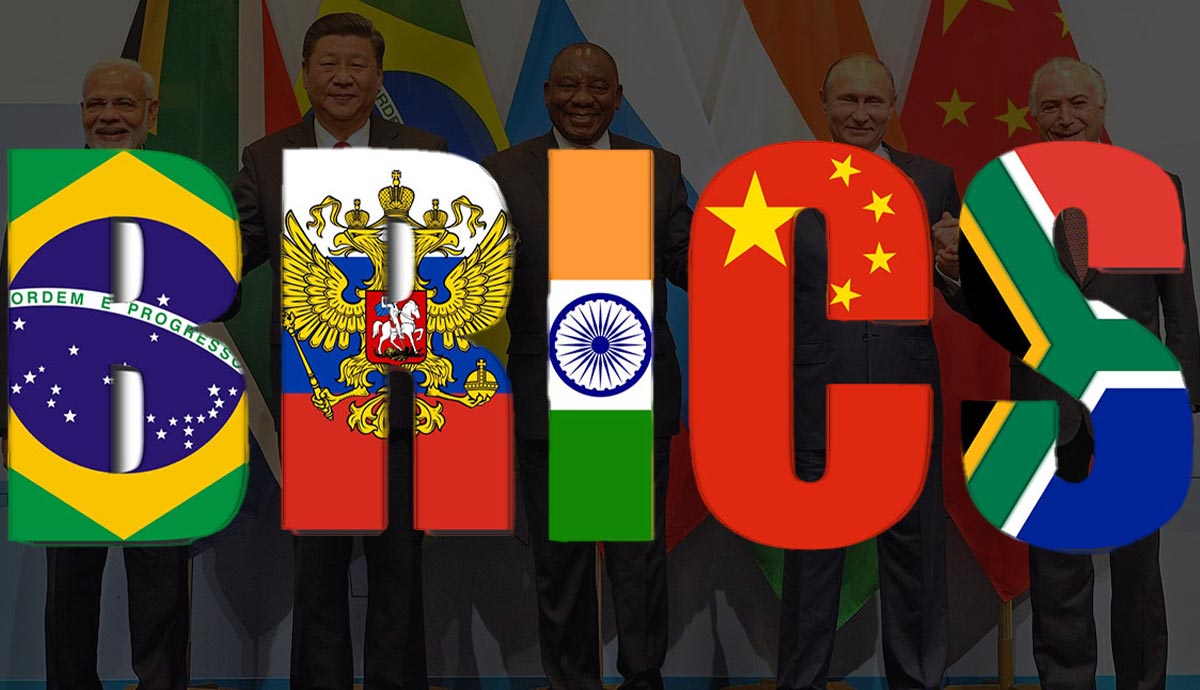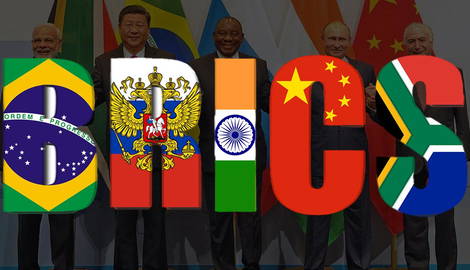
In a world that has been dominated economically by Western powers for centuries, BRICS is a trading bloc that has challenged the status quo and threatened to upset the established world order.
The implications of what this trading bloc means for those within it and those left outside are far-ranging. With dynamic initiatives tackling economic, social, and security matters, BRICS is a powerful force in forging ties between its member states. With a long list of applicants wishing to join the bloc, there is no doubt that the organization’s economic power will become one of the most influential factors determining the course of progress in the world.
The BRICS Members and Their Combined Output

Originally formed in 2001 and given the acronym “BRIC” to represent its constituent members, the founding members were Brazil, Russia, India, and China. Noticing the potential of BRIC early on, South Africa was the first country thereafter to apply for membership. In December 2010, South Africa was admitted as the fifth member, and the bloc was renamed BRICS, with the “S” representing its newest member.
Out of a world population of around eight billion, the BRICS countries represent almost 3.3 billion people. In this context, BRICS is the largest trading bloc in the world.
The combined nominal gross domestic product (GDP) of BRICS represents 26.6% of the gross world product, and adjusted for purchasing power parity (PPP), this percentage jumps to 32.5% of the world total.
These percentages are set to increase substantially as new members are accepted into BRICS in the very near future. At the 15th Annual BRICS Conference held in Johannesburg, South Africa, on August 22 – 24, six new countries were invited to join the economic alliance. Iran, Saudi Arabia, the United Arab Emirates, Egypt, Ethiopia, and Argentina. Their membership will become official on January 1, 2024, and together, the 11 members of BRICS(+) will represent a much stronger alliance, that among other things, accounts for half the world’s oil production.
While the member states are also members of other trading blocs, such as ASEAN, which represents a sizeable chunk of the world’s economy, or SADC, which covers Southern Africa, the BRICS nations are unified in terms of the BRICS dynamic of its members being developing economies, and ones that wish to do trade in a way that bypasses the US dollar. As such, it is often seen as an alternative to the Western power dynamic.
BRICS has helped foster a sense of friendship between its constituent members, and the countries have built significantly close ties, even helping to improve relations between India and China, who have had territorial disputes for many decades.

The constituent members are all vastly different. Economic and cultural histories certainly cannot be said to have much in common. What is appealing is the ability of these diversities to complement each other in ways that achieve significant progress in a spirit of cooperation rather than rivalry. China has a vast labor force, Russia has huge amounts of natural resources, while India is a large supplier of software – a critical product in the modern world, along with technicians and engineers that are highly sought after on the international stage. South Africa provides political influence over the continent of Africa, a region that holds a lot of interest for the Chinese, while Brazil has close ties with all the other members and offers significant investment opportunities.
What all the countries do have in common is the desire to break free of the constrictions evident in a unipolar world where the United States holds economic and political dominion. BRICS, in this regard, has worked to achieve unified success in its own right rather than trying to do so by destroying Western institutions. This is to say BRICS does not seek to weaken the West but rather to strengthen the Global South.
Annual BRICS summits have been held since 2009, with the first two being BRIC summits (without South Africa). The first summit was hosted in Sochi, Russia, and since then, the summit has been hosted on a rotational basis. Each summit has specific ideas and themes that are discussed.
BRICS Initiatives

Through the BRICS Summits, various initiatives and programs have been discussed for the potential development of the BRICS nations. In 2012, the building of the BRICS Cable, an undersea internet cable linking the BRICS countries, was announced. The reason for its construction was stated to “ensure that developing nations’ communications are not all in the hands of the nations of the North.” It is also intended “to circumvent the US and NSA spying.”
The upcoming summit in Durban, South Africa, will discuss the implementation of a BRICS currency, with its creation being intended to circumvent having to trade through the US dollar.
One of the biggest initiatives is the New Development Bank (NDB), which acts as a counter to the Western-dominated International Monetary Fund (IMF) and the World Bank. The NDB has amassed a huge pool of billions of dollars, and it has funded the creation of many industrial initiatives in developing countries. Green energy solutions, transport, sanitation, water projects, food protection, and environmental issues form the bulk of the NDB’s loan approvals.

The stated objectives of the NDB can be summarized as promoting infrastructure and sustainable development projects to improve conditions in member countries, partnering with other global entities in a spirit of cooperation, and building a balanced portfolio that gives the deserved respect to entities according to their geographic location and financing requirements among other factors.
In addition, the BRICS has also implemented a spirit of cooperation through sports and cultural showcases. The BRICS Games are intended to be held as yearly events and feature many sports popular in the constituent countries.

With the development of the NDB, BRICS has also contributed significantly to poverty alleviation, with the aim of reducing international disparities.
Other developments include an initiative to tighten control over the information sector to challenge the dominance of the United States. First proposed in 2015, this initiative was furthered in 2019 with the signing of a letter of intent by the BRICS nations to cooperate in the Information and Communication Technology sector.
Through initiatives like these, BRICS has become a voice for the Global South and given poorer countries a bigger stage in geopolitical trends.
BRICS Security Cooperation?
The expansion of BRICS’ influence on the world stage has opened many doors for developing economies. Through close ties, BRICS has fostered a greater ability to cooperate on security concerns.

Unlike NATO, however, BRICS is not a military alliance, and it is unlikely that BRICS will develop into such an institution with fully realized military ambitions. This, however, does not mean that BRICS will not investigate matters in this direction and create limited capabilities with regard to promoting a multi-polar world where the West doesn’t dominate through hard power.
The reality is that while economic concerns are certainly foremost on the BRICS agenda, it simply cannot ignore the very real factors of conflicts, territorial disputes, nuclear proliferation, international crime, and other instances where military force becomes a necessary political move to protect certain interests.
It is a major concern of the BRICS nations that organizations like NATO, and even the United Nations are dominated by Western interests. As such, BRICS has sought to amend the UN to be more inclusive and to reflect the fact that the balance of global power has shifted since the creation of the UN after the Second World War. This is especially relevant since the current member countries have significantly contributed to global peace and to the UN. South Africa, in particular, plays a major role in peacekeeping operations across the African continent.
The creation of BRICS was not born out of the desire to be an opponent to the West, but political developments have shaped the world into a dichotomy of East versus West that cannot be ignored. What the Western powers do to mitigate the growing power of their rivals remains to be seen, but rising tensions and deteriorating relations will provide challenges that may push BRICS in a direction that it had sought to avoid.
BRICS Expansion

The popularity of BRICS and the confidence that many countries have in it has spoken volumes. As of June 2023, thirteen countries have officially asked to join BRICS, while another six have asked informally, with many other countries showing interest as well.
Currently, the bloc is discussing the admission of several countries that have applied, including Indonesia, Egypt, Iran, the United Arab Emirates, Argentina, Bahrain, and several others. Of particular note is the addition of Saudi Arabia, which is set to join in 2023. This is an alarming development for the United States, especially if BRICS introduces its own currency. The resultant effects could be the European Union ditching the US dollar and trading directly with Saudi Arabia via the new BRICS currency when it is introduced. With other countries in the Middle East wishing to join, the US could lose its easy access to oil, which could trigger panic as global power shifts from West to East.

What can be clearly seen is that BRICS is a rapidly growing organization with a political influence that is playing a significant role in geopolitical dynamics. Developments in the political and economic sphere paint a bright picture for the future of BRICS, and it is wholly conceivable that BRICS will become a dominant force in world economics, supplanting many other established trading blocs as the most powerful economic bloc. It is also conceivable that this will evolve into shared political identities and motivations that will turn the bloc not just into an economic counter to Western dominance but a counter to political dominance as well.
Sources:
Slonskaya, M. The Role of BRICS in Global Security, MGIMO-University, 2015
Twinkle, M. Explained: BRICS And Its Relevance In The Contemporary Global Order, India Times https://www.indiatimes.com/explainers/news/brics-and-its-relevance-in-the-contemporary-global-order-570802.html
Devonshire-Ellis, C. The New Candidate Countries For BRICS Expansion, Silk Road Briefing, 2022. https://www.silkroadbriefing.com/news/2022/11/09/the-new-candidate-countries-for-brics-expansion/
York, G. and Griffiths, J. BRICS expansion plan could create new rival for U.S. dollar, the Globe and Mail. 2023. https://www.theglobeandmail.com/world/article-brics-expansion-membership/










